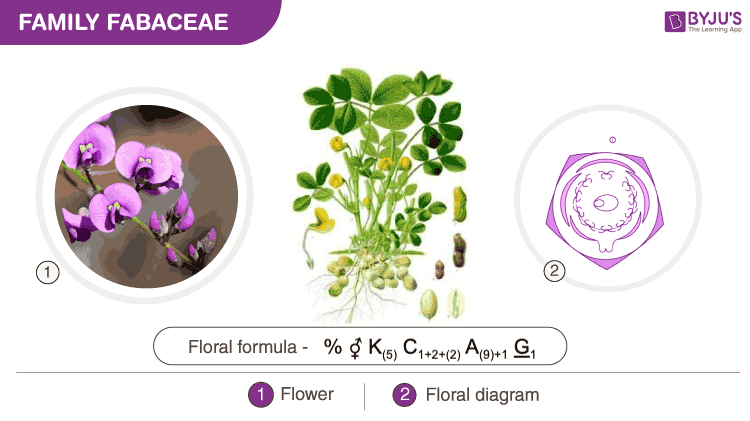Fabaceae (pea family) is a large family of angiosperms. It is also known as Leguminosae and the plants are commonly known as legumes. It is widely distributed all over the world. It includes many important pulses such as peas, soybean, chickpeas, etc.
Download the Complete Guide to NEET UG Prep
Download Now

Table of Content:
Floral Formula
A floral formula is a symbolic representation of different floral parts, their numbers, arrangement pattern and how they are related. The floral formula of Pisum sativum (peas) of the Fabaceae family is as follows:
% ⚥ K(5) C1+2+(2) A(9)+1 G1
Here the symbols represent:
| % | Zygomorphic (bilateral symmetry) |
| ⚥ | Bisexual |
| K(5) | Calyx – 5 sepals, gamosepalous (united) |
| C1+2+(2) | Corolla – 5 petals, polypetalous |
| A(9)+1 | Androecium – 10 stamens, diadelphous |
| G1 | Gynoecium – monocarpellary, superior ovary |
Systematic Position Of Fabaceae
Kingdom: Plantae
Subkingdom: Tracheobionta
Super Division: Spermatophyta
Division: Magnoliophyta
Class: Magnoliopsida
Subclass: Rosidae
Order: Fabales
Family: Fabaceae
Features Of Fabaceae Family
Some Common Plants
Fabaceae (pea family) is the third-largest family of angiosperms. It contains ~750 genera and ~20,000 species. Astragalus, Acacia, Indigofera, Crotalaria and Mimosa are five of the largest genera of the Fabaceae family. Some common examples are:
| Common name | Scientific name |
| Acacia | Acacia |
| Alfalfa | Medicago sativa |
| Mulethi (Liquorice) | Glycyrrhiza glabra |
| Common bean | Phaseolus vulgaris |
| Pigeon pea (Arhar) | Cajanus cajan |
| Mung bean | Vigna radiata |
| Chickpea | Cicer arietinum |
| Cowpea | Vigna unguiculata |
| Fenugreek | Trigonella foenum-graecum |
| Hyacinth bean (Sem) | Lablab purpureus |
| Indigo (Neel) | Indigofera |
| Touch me not | Mimosa pudica |
| Sunn hemp | Crotalaria juncea |
| Peas | Pisum sativum |
| Peanuts | Arachis hypogaea |
| Soybean | Glycine max |
| Tamarind | Tamarindus indica |
| Broad beans | Vicia faba |
Description Of The Family
It is the third-largest family of flowering plants.
Habitat: Plants may be mesophytes, xerophytes or heliophytes.
Habit: Fabaceae family contains shrubs, trees and many annual and perennial herbaceous plants.
Root: The presence of root nodules is the characteristic property of the family. They contain nitrogen-fixing symbiotic bacteria (Rhizobium) in their root nodules.
Stem: Herbaceous or woody. The stem may be erect or climber.
Leaf: Leaves are mostly alternate, simple or pinnately compound with reticulate venation. Leaves are stipulate. They have swollen (pulvinate) leaf base.
Inflorescence: Mostly racemose type.
Flower: Generally zygomorphic, i.e bilaterally symmetrical and bisexual. The flower is generally pentamerous and hypogynous.
Calyx: Five sepals, gamosepalous and show valvate or imbricate aestivation.
Corolla: Papilionaceous and polypetalous petals with vexillary aestivation. Five petals, one posteriorly placed, two lateral, called wings and two anterior, enclosing stamens and pistil, which is known as the keel.
Androecium: Stamens ten, diadelphous. Anthers with two lobes, i.e. dithecous.
Gynoecium: Mono carpellary with the superior and unilocular ovary. Each locule contains many ovules. It contains one curved style.
Fruit: Legume
Seeds: Nonedospermic and with two cotyledons.
Pollination: Members of this family mainly exhibit entomophilous pollination, i.e. pollinated by insects.
Economic Importance
- Many plants provide pulses, e.g. moong, bean, arhar dal, masoor dal, gram, soybean, sem, etc.
- Many plants are a source of edible oil such as peanuts, soybean, etc.
- Indigo is a widely used dye we get from Indigofera.
- Some of the plants yield fibres, e.g Sunn hemp.
- Many plants have medicinal properties. E.g. Mulethi is a very effective remedy for cough.
- Some of the plants are used for ornamental purposes, e.g. Sesbania, Lupinus, sweet pea, etc.
To sum up, in general, the flowers of the Fabaceae family are zygomorphic, bisexual, pentamerous and hypogynous.
Calyx has five sepals, which are united or gamosepalous with valvate or imbricate aestivation.
Corolla consists of five petals, which are polypetalous with vexillary aestivation.
Androecium contains ten diadelphous stamens.
The gynoecium is monocarpellary with a superior ovary.
You just read about the floral formula of the Fabaceae family. For more such information related to NEET, visit BYJU’S.
Further reading:
- Floral Formula Of Solanaceae
- Floral Formula Of Hibiscus
- Floral Formula Of Liliaceae
- Flashcards Of Biology For NEET Morphology Of Flowering Plants
Recommended Video:

Frequently Asked Questions
What are leguminosae?
Leguminosae or Fabaceae is a family that includes the agriculturally significant angiosperms. It is also commonly called as pea family, bean or legume family.
Give some examples of leguminosae?
It includes a wide variety of peas, beans and other legumes. Some examples are soybean, pea, chickpeas, wild bean, peanut, liquorice, alfalfa, etc.

Comments